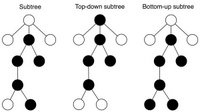
Amber Frid-Jimenez: has a really nice page showing document icons that reflect the words contained in the document. Neat idea, and has a lot of potential. One obvious extension to phylogenetics would be to represent the taxonomic coverage in a similar style, so people could very quickly find studies on related sets of organisms simply by browsing.




